Exploring Outpost Estates: Architectural Marvels
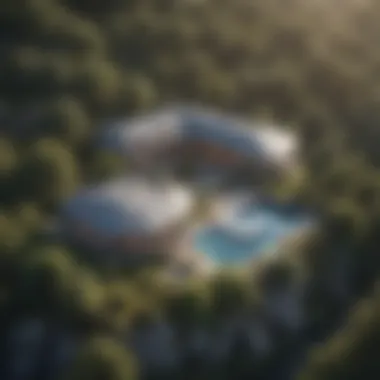

Intro
Outpost estates are captivating structures, often secluded and positioned in unique locations. These homes are not just places to live; they are architectural statements that reflect creativity and the surroundings they inhabit. Understanding their architectural significance goes beyond aesthetics; it involves grasping their historical context and the principles that guide their design. This segment explores those aspects, providing readers with an insightful overview of what makes outpost estates noteworthy.
Exquisite Architectural Designs
The design of outpost estates stands out, often merging with the environment rather than opposing it. These structures boast clean lines and functional spaces, appealing to both the eye and the mind.
Unique Home Features
Many outpost estates feature innovative designs, characterized by:
- Sustainable materials: Elements like reclaimed wood and recycled steel are common.
- Open floor plans: These layouts enhance the sense of space and light, inviting the outside in.
- Local craftsmanship: Many owners choose to work with local artisans to ensure that their homes resonate with the local culture.
- Integrative landscapes: Homes that blend in with their surroundings often utilize natural contours and native flora.
These features not only add character but also contribute to a sense of harmony with nature.
Historical Significance
The concept of outpost estates is rich with history. They often originate from a desire for retreat and personal sanctuary. The modern fascination with minimalism and sustainability can be traced back to these early estate designs. Each structure tells a story of adaptation to its environment. They speak to cultural shifts, economic factors, and even environmental awareness throughout the decades. Understanding these historical layers provides a deeper appreciation for the aesthetics and functionality these homes offer.
Interior Decorating Tips
Moving inside an outpost estate, the design should remain cohesive with the architecture. It is vital to create an inviting space that resonates with the overall essence of the home while maintaining individual charm.
Color Schemes and Trends
When selecting colors, consider:
- Earthy tones: Browns, greens, and tans that echo the natural surroundings.
- Accent colors: Bright hues can add personality without overwhelming the space.
- Textures: Layering different materials provides depth and interest. For instance, a soft wool blanket might contrast beautifully against a sleek leather sofa.
This thoughtful approach to color not only beautifies but also reflects the external environment and encourages tranquility.
Space Optimization Techniques
Efficient use of space is crucial in outpost estates. Here are some strategies:
- Multi-functional furniture: Choose pieces that serve more than one purpose.
- Built-in storage: Custom cabinetry can maximize space without sacrificing style.
- Strategic lighting: Use natural light whenever possible, supplemented by strategically placed fixtures for evening ambiance.
These techniques ensure that every nook serves a function while remaining aesthetically pleasing.
"The beauty of an outpost estate lies not just in its design, but in the lifestyle it promotes; a balance between luxury and nature, simplicity and elegance."
Moving from the exterior beauty of these estates to the interior nuances allows potential buyers and enthusiasts to understand how to create their own sanctuary that mirrors the charm of these distinct properties. Through this exploration, one can appreciate how outpost estates encapsulate both architectural significance and a vibrant way of life.
Prolusion to Outpost Estates
Outpost Estates is an intriguing topic in the realm of architecture and real estate. These unique properties stand out not only for their location but also for the philosophies and principles that shape their creation. Embracing the interplay between nature and design, outpost estates often serve as retreat spaces away from the complexities of urban life. In this exploration, we will unravel the essence of an outpost estate. It is important to understand what makes these structures significant within both historical and modern contexts.
Defining Outpost Estates
Outpost Estates can be defined as residential properties strategically placed in extraordinary locations. These homes are characterized by their architectural uniqueness and intentional blending with their surroundings. Location plays a crucial role in their appeal, as they tend to be situated in scenic areas, such as mountains, forested regions, or along coastal lines. The term 'outpost' implies a sense of isolation and tranquility, which many homeowners seek.
The design of an outpost estate often reflects a strong connection to nature. Features like large windows, open floor plans, and natural materials emphasize this relationship, allowing residents to experience the beauty of their environment up close. Outpost Estates can range widely in style; from modern minimalist designs that prioritize clean lines to more rustic cabins that embrace traditional craftsmanship.
The Role of Outpost Estates in Modern Architecture
Outpost Estates hold a significant place in modern architecture. They challenge the conventional boundaries of residential design. By focusing on sustainability and ecological harmony, these properties push for more thoughtful approaches to living spaces. The modern architectural landscape is increasingly moving toward integrating indoor and outdoor living.
Additionally, outpost estates often embrace environmentally friendly practices. Many are designed to reduce energy consumption, utilizing renewable resources and sustainable materials. Innovations may include solar panels, rainwater harvesting systems, and smart home technology, which makes living there more efficient.
In a world that is rapidly urbanizing, outpost estates represent a counter-movement. They invite individuals to reconnect with nature and prioritize personal well-being, without compromising on modern conveniences. This architectural approach resonates with a growing demographic, eager to seek a balance between comfort and lifestyle choices.
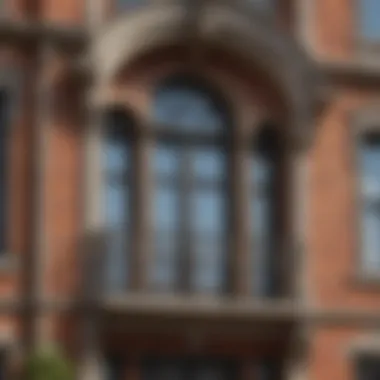

Historical Context
Understanding the historical context of Outpost Estates is crucial for appreciating their architectural and cultural significance. These unique properties represent more than mere residential options; they are reflections of evolving design philosophies, landscape integration, and the aspirations of the communities they inhabit. The historical backdrop provides insights into the motivations behind their development, the architectural trends that influenced their design, and the broader socio-economic factors at play across different eras.
Origins of Outpost Estates
Outpost Estates began taking shape in the early to mid-20th century, a time when architectural innovation was flourishing. The origins can be traced back to a reaction against urban overcrowding and the desire for more individualistic living spaces. Settlements in natural surroundings became preferable for many people, leading to the creation of these estates. Architects and builders saw the opportunity to design homes that blended with the environment, taking advantage of the natural landscape while offering a retreat from the hustle of city life.
Influential figures in architecture contributed to the formation of these estates, emphasizing the need for functional beauty. Notable architects such as Richard Neutra and Frank Lloyd Wright pushed boundaries regarding form and material. They sought to create not just homes, but harmonious living spaces that resonated with their surroundings. This period marked a significant turn in residential architecture, where aesthetics and usability were balanced against the backdrop of a growing environmental consciousness.
Evolution Through the Decades
As society changed, so did Outpost Estates. The evolution from simple retreats to complex architectural statements showcases the shifting values of different decades. In the 1950s and 1960s, economic prosperity contributed to an increase in the demand for vacation homes. During this period, Outpost Estates adopted more modern materials and techniques. Large glass windows and open spaces became defining features, inviting nature inside while fostering a sense of connection with the outdoors.
By the late 20th century, there was a distinct movement towards sustainability. This shift encouraged architects to utilize eco-friendly materials and energy-efficient designs. The integration of these building practices was not just a trend; it was a necessary adaptation to growing environmental concerns. Therefore, Outpost Estates began evolving into models of sustainable living, incorporating technologies that minimized their ecological footprint.
Today, Outpost Estates continue to reflect contemporary values, adapting to modern lifestyles while preserving the essence of their origins. The ongoing evolution of these properties is a testament to their resilience and relevance in the changing landscape of architecture and real estate.
Architectural Elements of Outpost Estates
Architectural elements of Outpost Estates contribute significantly to their unique character and appeal. These elements define how these properties interact with their environment and how inhabitants experience them. Understanding these architectural aspects helps in appreciating the ingenuity involved in creating such residences. Not just mere structures, Outpost Estates embody thoughtful design that harmonizes beauty with functionality.
Design and Aesthetic Principles
When discussing the design and aesthetic principles of Outpost Estates, one cannot overlook the balance of form and function. Architects often emphasize clean lines, open spaces, and a connection to nature. These establishments usually mirror the style of the surrounding landscape.
- Use of Materials: Natural materials like wood and stone are frequently chosen. These materials not only blend well with the natural environment but also provide a sense of warmth and elegance.
- Color Palette: Neutral and earthy tones dominate the color schemes, allowing the properties to restore soothing visual harmony. This enhances the overall aesthetic while ensuring the buildings do not overpower their surroundings.
- Spatial Design: Open floor plans are common, enabling flexibility in living spaces. These designs facilitate a seamless flow between indoors and outdoors, enhancing the living experience.
Integration with Natural Surroundings
The integration of Outpost Estates within their natural settings is paramount. Effective architectural design takes advantage of geographical features, climate, and local ecosystems. This results in properties that welcome the outdoors into the indoor environment.
"The relationship between a building and its landscape is not just an aesthetic decision but an essential aspect of sustainable living."
- Landscape Design: Landscaping often involves native plants, minimizing the need for water and maintenance. The natural flora enhances the estate's beauty while supporting the local ecosystem.
- Views and Orientation: Many Outpost Estates are designed to maximize viewpoints. The orientation of windows and patios ensures that residents enjoy natural light and scenic vistas, contributing to a feeling of connectedness with nature.
- Outdoor Spaces: Outdoor living areas are common features. Terraces, decks, and gardens allow residents to enjoy their environment fully, blurring the line between indoor and outdoor experiences.
Sustainable Building Practices
Sustainability is a critical concern in the architectural realm, and Outpost Estates are no exception. Builders focus on eco-friendly practices that enhance energy efficiency and reduce the environmental footprint.
- Energy Efficiency: Many homes implement solar panels and high-performance insulation, which drastically reduce energy consumption. These features create long-term savings while aligning with modern environmental standards.
- Water Management: Rainwater harvesting and greywater recycling systems can be integrated into the design, ensuring responsible use of natural resources.
- Local Sourcing: By sourcing materials locally, architects minimize transportation emissions, supporting regional economies. This practice contributes to a more sustainable construction approach.
Diverse Locations of Outpost Estates
The locations of outpost estates play a crucial role in their appeal and functionality. Each site offers distinct environmental characteristics and lifestyle opportunities. The choice of location not only influences the architectural style but also the daily experiences of those who inhabit these unique spaces. Outpost estates are often located in areas that naturally emphasize isolation, luxury, and harmony with the environment. They serve as personal havens, allowing homeowners to enjoy their surroundings and engage with nature in unique ways.
Mountain Retreats
Mountain retreats exude a special charm. These outpost estates often boast breathtaking views and proximity to outdoor activities such as skiing, hiking, and mountain biking. The air is fresher, and the pace of life tends to be slower, attracting those who wish to escape urban chaos.
The architectural choices in mountain retreats often integrate local materials, resulting in structures that harmoniously blend with their surroundings. Wood, stone, and large glass windows are common elements, ensuring that residents can appreciate the stunning landscapes. Many of these retreats are designed to maximize natural light and minimize environmental impact while providing a cozy atmosphere, perfect for relaxation after a day of exploration.
Coastal Escapes
Coastal escapes are another popular choice for outpost estates. Living by the ocean provides residents with unique benefits, such as stunning sunrises and the sound of waves as a constant backdrop. Coastal properties often emphasize open spaces and outdoor living areas, such as patios and decks, which enhance the connection to the waterfront.
Architecturally, coastal estates frequently feature large windows and open floor plans that make the most of the panoramic views. Materials used are generally weather-resistant due to the harsher conditions present near the sea. From modernist designs to traditional beach cottages, the appeal of a coastal outpost estate lies in its ability to offer a serene lifestyle paired with the beauty of nature.
Urban Outpost Estates
Urban outpost estates present a different yet equally fascinating option. These properties are often integrated into vibrant cityscapes, offering convenience and access to cultural activities. Urban estates can range from renovated lofts to modern high-rises, each providing a unique living experience that combines comfort and urban life.
The challenge for architects in urban settings is to create spaces that feel like retreats while still being connected to the hustle and bustle of the city. This can involve using design techniques such as soundproofing, creating green spaces with rooftop gardens, and incorporating elements that promote relaxation within a busy environment. Living in an urban outpost estate often fosters a sense of community while still allowing for personal sanctuary within the city.
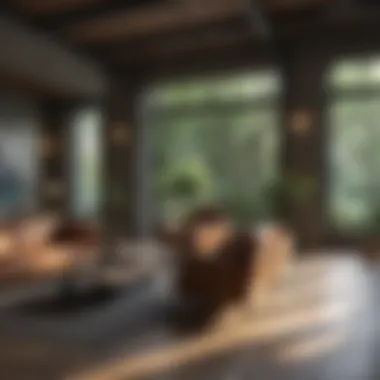
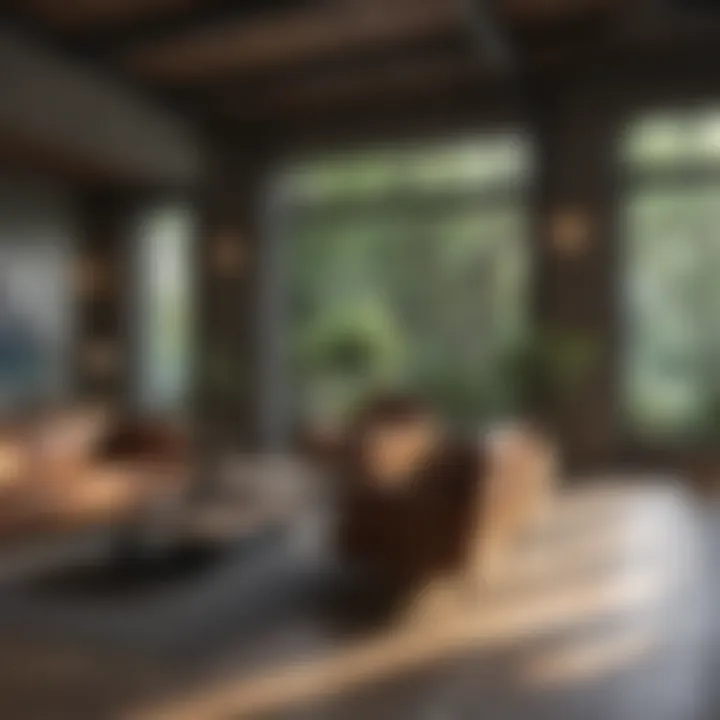
"The location of an outpost estate shapes not only its architectural design but also the lifestyle experiences of its inhabitants."
Case Studies of Notable Outpost Estates
Examining case studies of notable outpost estates is crucial for understanding their architectural uniqueness and cultural impact. These estates serve as exemplars of innovation, reflecting the values and aspirations of their times. By analyzing specific examples, one can grasp how design principles are applied, how they navigate environmental challenges, and how they establish a sense of place that resonates with inhabitants and visitors alike.
Case studies can offer tangible insights into the diversity of outpost estates, from mountain retreats to urban gems. They showcase practicality in design while maintaining aesthetic integrity. Furthermore, these examinations serve as a bridge between the past and the future, illustrating evolving trends and potential directions in architectural design.
Innovative Designs
Innovative designs within outpost estates often push the boundaries of traditional architecture. One prevalent example is the Treetop House located in the lush forests of Oregon. This residence utilizes cantilevered structures, allowing it to merge seamlessly with its natural surroundings. Such designs not only aim for visual appeal but also prioritize functionality. For instance, the use of glass walls enhances natural light, creating a sense of openness.
Another notable example is the Wave House in Malibu, California. The fluid, wavy exterior of this property represents a cutting-edge design approach, improving both wind resistance and aesthetic charm. Innovative features include sustainable roofing materials and solar panels, integrating eco-friendly practices into luxury living.
"Innovative designs in outpost estates reflect a commitment to both beauty and sustainability, merging human needs with environmental stewardship."
These types of estates illustrate how modern architecture can be both sculptural and practical. They challenge conventional design norms while also addressing environmental concerns, offering blueprints for future developments.
Historical Significance
The historical significance of outpost estates cannot be overlooked. Many of these properties have witnessed, and even influenced, cultural and architectural movements within their regions. For example, the Cliff House in San Francisco can trace its lineage back to the mid-19th century. It reflects the Victorian architectural style, and its presence has become iconic in the region.
Additionally, the Case Study Houses, built in Los Angeles in the late 1940s, highlighted the modernist movement's principles. These houses were designed to showcase new materials and building methods, leaving a lasting impact on contemporary architecture. The simplicity and functionality they promoted continue to inspire architects and homeowners today.
Moreover, these estates often embody the spirit of social movements, addressing changing lifestyles and values. By understanding their historical context, one not only appreciates their aesthetic but also the narrative they weave into the fabric of local culture and identity.
In summary, the case studies of notable outpost estates offer influence beyond their immediate environment. They provide invaluable lessons in design, sustainability, and history.
Personal Experience: Living in an Outpost Estate
Living in an outpost estate is a unique experience that many find enriching. It transcends the usual confines of home and shifts focus to a symbiotic relationship between architecture, environment, and the personal journey of the residents. Each outpost estate carries its distinct narrative, informed by its location and design. This section covers the significance of living in these architectural wonders, emphasizing lifestyle considerations and the balance between community and isolation, which are pivotal for residents.
Lifestyle Considerations
When considering life in an outpost estate, various lifestyle factors come into play. One primary element is the integration of indoor and outdoor spaces. Homeowners often enjoy views that are breathtaking and invite nature inside. Large windows and open-plan designs are common, which provide a harmonious atmosphere that enhances daily living.
Moreover, living in such unique settings often demands a certain mental approach. Residents may find themselves adapting to a more minimalist lifestyle. This can mean prioritizing experiences over possessions, as the environment encourages interaction with nature rather than accumulation of material goods.
Some specific considerations include:
- Privacy: Many outpost estates are nestled away from urban centers, allowing for a retreat from the daily hustle and bustle. This peace can be incredibly rejuvenating for individuals.
- Accessibility: Depending on the location, some estates may be hard to reach. This might positively impact one’s lifestyle as challenges require planning and mindfulness.
Additionally, the challenges posed by seasonal weather can affect lifestyle choices. Those living in mountain retreats must adjust their activities based on the changing seasons, highlighting a more dynamic way of life. The embrace of such a versatile lifestyle can lead to personal growth and resilience.
Community and Isolation
The duality of community and isolation is a hallmark feature of outpost estates. On one hand, these homes foster a distinct sense of community among residents. Neighbors often share similar values focused on sustainability and appreciation for the environment. Living close to like-minded people fosters connections that can lead to lasting friendships. This collective ethos can often enhance the living experience.
On the other hand, isolation is a prominent aspect that many residents value too. The distance from crowded cities provides a sanctuary for introspection and solitude. Individuals can retreat into their own space away from everyday noise, creating a haven for creativity and reflection. It is crucial to navigate this balance; some may thrive in complete solitude, while others may lean towards seeking frequent connections.
In summary, living in an outpost estate is not only about enjoying unique architectural features but also embracing the lifestyle that these settings offer. With thoughtful integration of community dynamics and personal space, residents can find their ideal living situation, enhancing both their mental well-being and overall quality of life.
Market Trends for Outpost Estates
The examination of market trends for outpost estates has become increasingly relevant in understanding their appeal and viability as both lifestyle choices and investment opportunities. As interest in unique living arrangements grows, so does the exploration of market dynamics surrounding these exceptional properties. Several key factors play a significant role in shaping these trends, including demographic shifts, changing consumer preferences, and economic influences that affect the housing market overall.
Investment Potential
Investment in outpost estates can be a promising endeavor. These properties tend to attract a niche market looking for distinctive architecture and tranquil settings. The potential for appreciation is relatively high, particularly in areas that are experiencing urban outflow or a retreat to nature due to remote work options. For investors, the uniqueness of these estates often means they stand out in listings, leading to faster sales and the opportunity for above-average returns.
Investors must consider various elements:
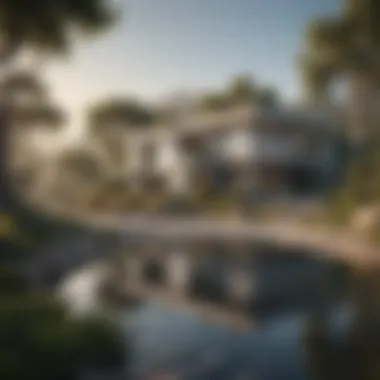

- Location is crucial. Estates in scenic or culturally rich areas tend to retain their value.
- Quality of construction and design features can greatly affect the marketability of the property.
- Sustainability features are gaining interest as buyers become more eco-conscious. Properties that incorporate green technologies not only appeal to a larger audience but may also qualify for incentives and grants.
Rising Demand and Future Prospects
The demand for outpost estates shows no sign of waning. Several trends indicate a robust future for these unique properties. As urban populations become more crowded and people seek refuge from the hustle and bustle of city life, many are looking to outpost estates as a solution. The combination of architectural wonder and a desire for escapism drives this trend.
Moreover, remote working has transformed the landscape of residential preferences. Professionals no longer need to live near their offices, allowing them to explore distant locations with luxurious properties. The desire for retreat spaces leads many to seek out outpost estates, which often offer breathtaking views and a connection to nature.
Factors influencing rising demand include:
- Increased urbanization leading to crowded living conditions.
- The trend towards minimalism and simple living, prompting a search for unique spaces that resonate with these values.
- The influence of social media showcasing these estates, thereby enhancing their appeal.
As a result, the future of outpost estates appears bright, with sustained interest from diverse demographics looking for unusual and beautiful living environments.
Practical Advice for Prospective Buyers
When considering the purchase of an outpost estate, prospective buyers should approach the decision with clarity and intentionality. Outpost estates offer unique architectural designs and prime locations, but they also come with specific challenges. This section aims to equip you with the essential insights needed to make informed choices.
Evaluating Potential Purchases
Evaluating potential purchases of outpost estates requires thorough research and inspection. Start by assessing the location you are interested in. Factors like accessibility, nearby amenities, and natural surroundings should weigh heavily in your analysis.
Before committing to a property, conduct a detailed inspection. Look beyond aesthetics; analyze the structural integrity of the building and the quality of materials used in construction. Understanding the architectural style can also help you appreciate potential upkeep needs.
Key considerations include:
- Condition of the Property: Hire a professional inspector to reveal any hidden issues.
- Architectural Significance: Learn about the estate's design and how it fits into the broader architectural context.
- Future Development Plans: Research local zoning and planning initiatives that could affect property value or livability.
Financing Outpost Estates
Financing outpost estates may differ from securing a traditional mortgage for a standard home. Due to their unique nature, many lenders require specific considerations.
Establish a clear financial strategy before initiating the buying process. Being aware of your budget is crucial. Here are some financial options to consider:
- Conventional Mortgages: Some lenders offer specialized loans tailored for unique properties.
- Personal Loans: These can supplement your financing for renovations or upgrades to the estate.
- Partnerships: If possible, consider co-investing with family or like-minded individuals.
It is wise to consult with a financial advisor experienced in unconventional property markets. They can help you identify the best financing options tailored to your situation.
Understanding Legal Considerations
Legal considerations are paramount when purchasing an outpost estate. These properties may fall under different regulations compared to traditional residential properties. It is essential to understand the legal landscape surrounding such purchases.
Tip: Always work with a legal professional who specializes in real estate transactions involving unique properties.
Important legal aspects include:
- Ownership Rights: Review any covenants or restrictions that may affect your ownership.
- Zoning Regulations: Ensure that the property’s zoning allows for your intended use.
- Local Laws: Familiarize yourself with property taxes, permits, and amenities that may impact your investment.
In summary, being well-informed about evaluating potential purchases, financing options, and legal considerations significantly enhances your chance of a successful investment in an outpost estate.
Ending
The conclusion serves as a crucial element in this article, bringing together the various threads discussed throughout the exploration of Outpost Estates. It encapsulates the architectural significance of these unique residences, highlighting their charm and the various design principles at play. In addition, it reflects on the lifestyle considerations and the practical aspects of engaging with such properties.
Reflecting upon the appeal of Outpost Estates reveals numerous benefits. Firstly, they offer a distinct architectural style that often breaks conventional norms. This non-traditional approach appeals to those seeking individuality in their living spaces. Many outpost estates are designed to harmonize with their surroundings, allowing homeowners to enjoy nature while still relishing the comforts of contemporary living.
Key elements of appeal include:
- Unique architectural features
- Integration with natural landscapes
- Innovative design practices
Moreover, the lifestyle associated with living in these estates often encourages a sense of community while also providing an escape from urban noise. This mixture of proximity and privacy creates a perfect balance that appeals to various demographics, from families to professionals.
Looking forward, the future of Outpost Estates in architectural design is promising. As sustainability becomes a more prevalent concern, architects are increasingly designing homes that reflect eco-friendly practices. This trend not only prioritizes environmental impact but also enhances the aesthetic and functional aspects of housing.
There are several anticipated developments for Outpost Estates:
- Increased use of sustainable materials
- Adoption of smart home technologies
- Emphasis on energy efficiency
As these trends continue to evolve, Outpost Estates will likely remain at the forefront of architectural design. They represent a blending of art and living, appealing to a discerning audience that values both aesthetics and practicality. The discourse surrounding these estates is rich and varied, suggesting that their significance will only grow in future conversations about modern architecture.















